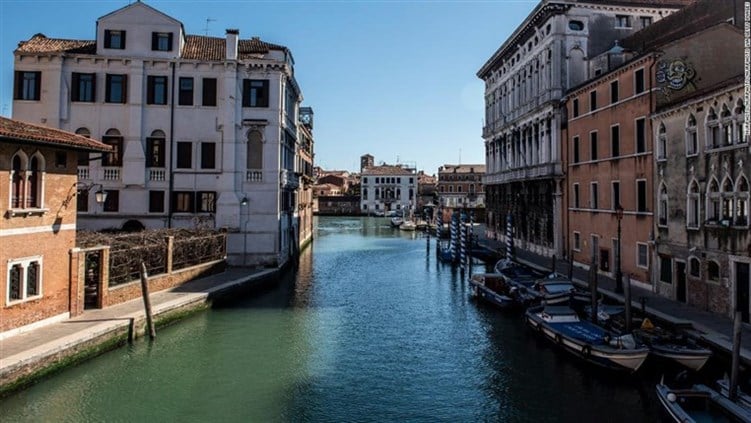After the discoloration of the waters in Venice… What are the “guidelines” for environmental protest?

After hours of widespread anxiety and controversy, investigations and laboratory tests conducted by the Italian authorities on the green discoloration of part of the Grand Canal in the city of Venice have revealed the presence of the non-toxic fluorescein, which is commonly used to examine sewage networks.
According to a local authorities statement, the tests “showed the presence of fluorescein in the samples taken”.
The results “did not prove the presence of poisonous elements in the samples that were analyzed,” he said, without specifying the source of the presence of the fluorine in the Grand Canal.
Fluorescein is usually used to track network path or to identify reflexes between sewage and rainwater systems.
Earlier on Sunday, a number of residents in the area reported a change in the color of the Grand Canal, amid much speculation. This is what prompted the governor of Venice to hold an emergency meeting of the police forces, to understand what happened and to study possible measures to combat it.
environmental protest controls
Italian media sources speculated that environmental lobbies may have been behind the incident of water coloring, drawing attention to the seriousness of the acceleration of environmental degradation around the world, and that this is most likely because the substance used is non-toxic and harmless.
According to experts and observers, this matter requires taking into account the rules of the path of protest and rejection against the worsening of the phenomenon of climate change, so that it does not contribute to more complicating the problem, instead of raising awareness of the problem and calling for its solution by peaceful means, without the use of materials and dyes that may have negative and harmful effects .
Ayman Kaddouri, an environmental expert and member of the International Union for the Protection of Nature, told Sky News Arabia :
* Major industrialized countries unfortunately continue to harm the environment by using traditional energy sources, slowing down the process of energy transformation, and not abiding by the legislation of climate summits. The most prominent of these is helping developing countries to confront the dangers of climate change and its effects, which cause severe changes and fluctuations in weather. The consequences of this change have become clear through the environmental disasters that hit the globe in all its forms.
* This is why, in parallel with the rise of the environmental danger facing the world, there is an increase in the number of protests by organizations and groups defending the environment and calling for the commitment of governments to implement the international laws that are passed to limit the phenomenon of global warming, which is the fuel for the growing process of climate change .
* Especially in the countries of the Southern Europe, which suffers from the magnitude of environmental effects and natural disasters, especially those that occurred in the last five years, which revealed the fragility of the preparedness and preparedness systems for natural disasters in Europe in general, and their inability to respond to climate crises such as drought, forest fires and floods.
* In addition to the spread of other fires in the South American continent in parts of the Amazon forests, specifically in Brazil, and floods in the African continent, with a succession of drought waves over parts of North America, especially in Canada.
* Thus, protest initiatives have spread widely around the world, and quite clearly on the European continent. To the extent that the fingers behind what happened in Italy, of painting the water of the main canal in the city of Venice in bright green, have gone towards environmental activists, especially that the authorities in Italy observed more than one similar case in various regions of the country in recent weeks.
* Some substances used in such cases to color water, other than the fluorescein that has been detected, may involve damage, such as organic matter (CDOM), which harms aquatic organisms, specifically aquatic plants, inhibits photosynthesis and is used in a laboratory to study water properties and determine purity by gradient.
* There is no doubt that organized and peaceful protest, far from causing public harm, is a right guaranteed by international conventions and human rights laws, provided that it does not harm the public and, at the environmental level, that it does not have environmental effects, which may be more lethal and have a faster negative impact than climate change itself.
series of accidents
Initial indications that environmental lobby groups may have been behind the accident have been based on recent events in Italy, where conservation groups have painted monuments, including the use of charcoal to black out the water of a rural fountain in Rome, in protest against the use of fossil fuels.
This is not the first time the Grand Canal’s water has turned green. In 1968, on the sidelines of the 34th Venice Film Festival, Argentine artist Nicolás García Auriboro threw green paint on the canal in an effort to raise awareness of environmental issues.












